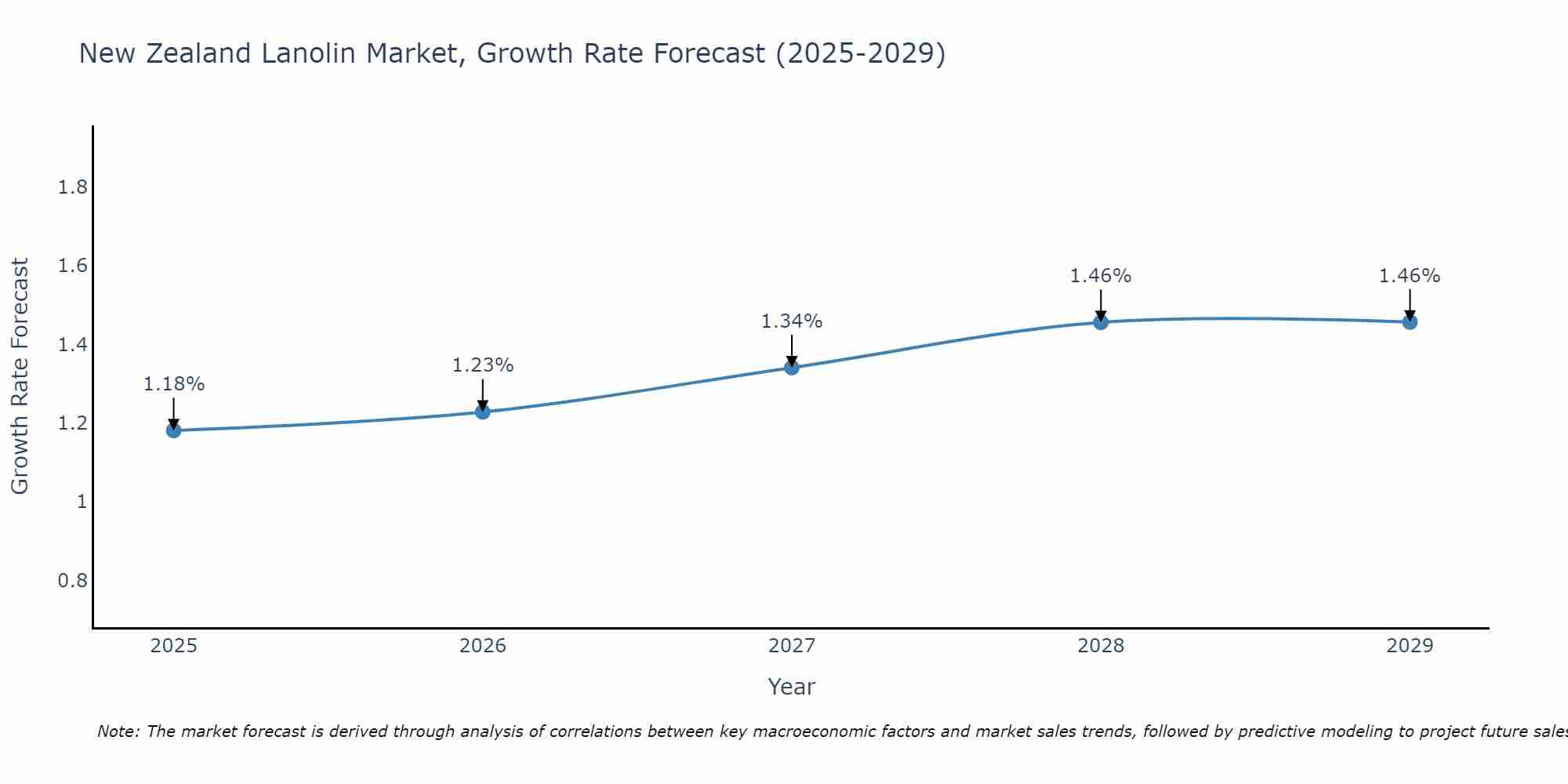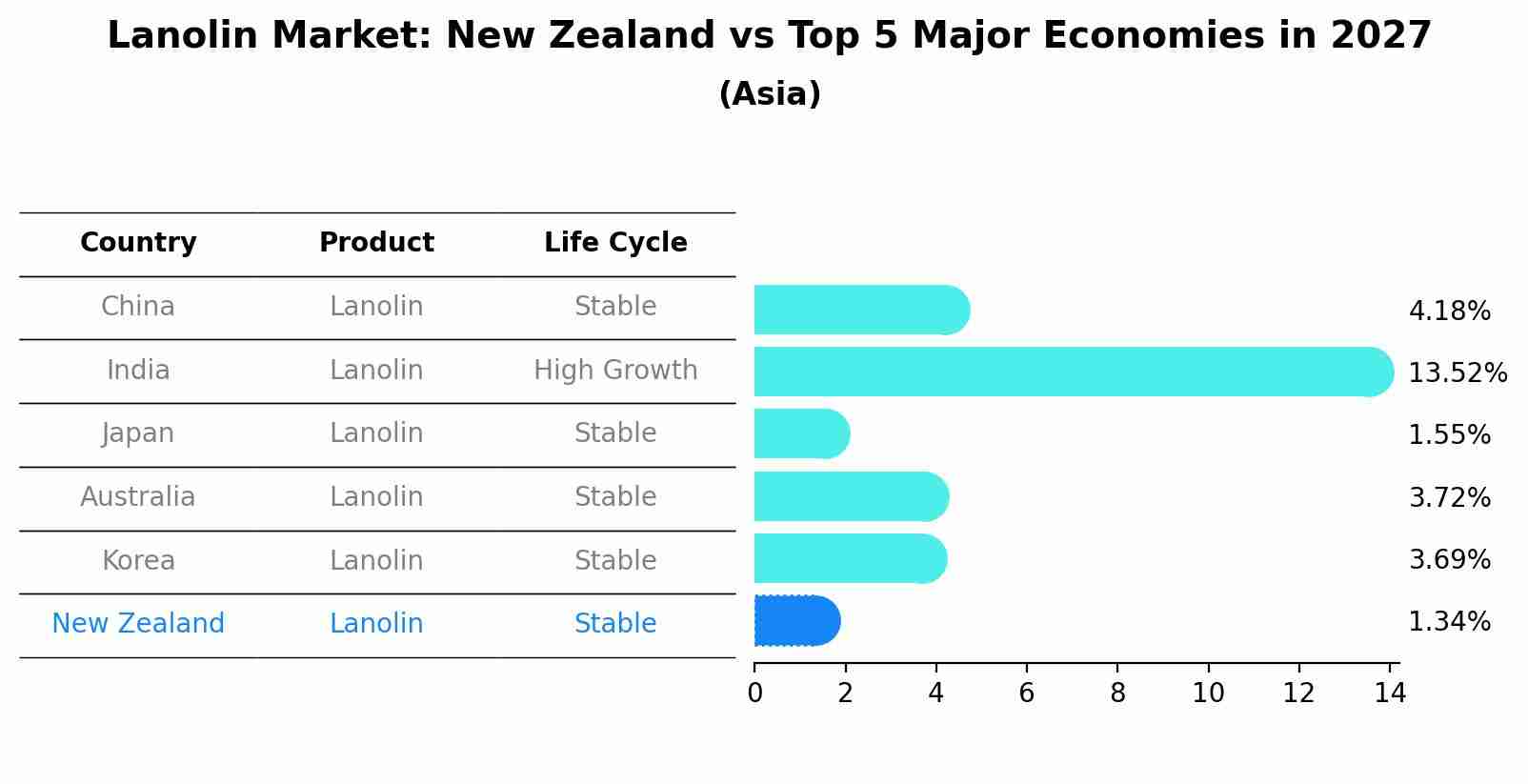New Zealand Lanolin Market (2025-2031) | Value, Segmentation, Share, Outlook, Size, Industry, Analysis, Trends, Companies, Revenue, Forecast & Growth
| Product Code: ETC5016838 | Publication Date: Nov 2023 | Updated Date: Sep 2025 | Product Type: Market Research Report | |
| Publisher: 6Wresearch | Author: Sachin Kumar Rai | No. of Pages: 60 | No. of Figures: 30 | No. of Tables: 5 |
New Zealand Lanolin Market Size Growth Rate
The New Zealand Lanolin Market is poised for steady growth rate improvements from 2025 to 2029. From 1.18% in 2025, the growth rate steadily ascends to 1.46% in 2029.

Lanolin Market: New Zealand vs Top 5 Major Economies in 2027 (Asia)
By 2027, the Lanolin market in New Zealand is anticipated to reach a growth rate of 1.34%, as part of an increasingly competitive Asia region, where China remains at the forefront, supported by India, Japan, Australia and South Korea, driving innovations and market adoption across sectors.

New Zealand Lanolin Market Overview
Lanolin, a byproduct of wool processing, is used in cosmetics and skincare products. The market is supported by New Zealand strong wool industry and the global demand for natural ingredients.
Drivers of the market
The lanolin market in New Zealand is driven by the growing demand for natural and sustainable ingredients in personal care and cosmetic products. Lanolin, derived from sheep`s wool, is widely used in skincare products due to its moisturizing and emollient properties. The rising consumer preference for natural and organic cosmetics is boosting the demand for lanolin. Additionally, the expanding pharmaceutical industry uses lanolin in topical formulations, further contributing to market growth. New Zealand strong wool production industry also supports the availability of raw materials for lanolin extraction.
Challenges of the market
The New Zealand Lanolin market faces challenges related to sustainability and ethical sourcing. As a natural product derived from sheep`s wool, maintaining environmental stewardship and animal welfare standards is paramount. Balancing the demand for lanolin with responsible farming practices and conservation efforts poses ongoing challenges. Moreover, fluctuating global demand and market dynamics necessitate agile strategies to adapt to changing conditions while ensuring the integrity of the product.
Government Policy of the market
Regulations ensuring the safety and quality of cosmetic and pharmaceutical products influence the lanolin market. Government support for the wool industry and natural products is significant.
Key Highlights of the Report:
- New Zealand Lanolin Market Outlook
- Market Size of New Zealand Lanolin Market, 2024
- Forecast of New Zealand Lanolin Market, 2031
- Historical Data and Forecast of New Zealand Lanolin Revenues & Volume for the Period 2021-2031
- New Zealand Lanolin Market Trend Evolution
- New Zealand Lanolin Market Drivers and Challenges
- New Zealand Lanolin Price Trends
- New Zealand Lanolin Porter`s Five Forces
- New Zealand Lanolin Industry Life Cycle
- Historical Data and Forecast of New Zealand Lanolin Market Revenues & Volume By Application for the Period 2021-2031
- Historical Data and Forecast of New Zealand Lanolin Market Revenues & Volume By Personal Care & Cosmetics for the Period 2021-2031
- Historical Data and Forecast of New Zealand Lanolin Market Revenues & Volume By BaCare Products for the Period 2021-2031
- Historical Data and Forecast of New Zealand Lanolin Market Revenues & Volume By Pharmaceuticals for the Period 2021-2031
- Historical Data and Forecast of New Zealand Lanolin Market Revenues & Volume By Industrial for the Period 2021-2031
- Historical Data and Forecast of New Zealand Lanolin Market Revenues & Volume By Others for the Period 2021-2031
- Historical Data and Forecast of New Zealand Lanolin Market Revenues & Volume By Derivative for the Period 2021-2031
- Historical Data and Forecast of New Zealand Lanolin Market Revenues & Volume By Lanolin alcohol for the Period 2021-2031
- Historical Data and Forecast of New Zealand Lanolin Market Revenues & Volume By Cholesterin for the Period 2021-2031
- Historical Data and Forecast of New Zealand Lanolin Market Revenues & Volume By Isopropyl Lanolate for the Period 2021-2031
- Historical Data and Forecast of New Zealand Lanolin Market Revenues & Volume By Laneth for the Period 2021-2031
- Historical Data and Forecast of New Zealand Lanolin Market Revenues & Volume By Lanogene for the Period 2021-2031
- Historical Data and Forecast of New Zealand Lanolin Market Revenues & Volume By Lanosterols for the Period 2021-2031
- Historical Data and Forecast of New Zealand Lanolin Market Revenues & Volume By Quaternium 33 for the Period 2021-2031
- Historical Data and Forecast of New Zealand Lanolin Market Revenues & Volume By Others for the Period 2021-2031
- New Zealand Lanolin Import Export Trade Statistics
- Market Opportunity Assessment By Application
- Market Opportunity Assessment By Derivative
- New Zealand Lanolin Top Companies Market Share
- New Zealand Lanolin Competitive Benchmarking By Technical and Operational Parameters
- New Zealand Lanolin Company Profiles
- New Zealand Lanolin Key Strategic Recommendations
Frequently Asked Questions About the Market Study (FAQs):
1 Executive Summary |
2 Introduction |
2.1 Key Highlights of the Report |
2.2 Report Description |
2.3 Market Scope & Segmentation |
2.4 Research Methodology |
2.5 Assumptions |
3 New Zealand Lanolin Market Overview |
3.1 New Zealand Country Macro Economic Indicators |
3.2 New Zealand Lanolin Market Revenues & Volume, 2021 & 2031F |
3.3 New Zealand Lanolin Market - Industry Life Cycle |
3.4 New Zealand Lanolin Market - Porter's Five Forces |
3.5 New Zealand Lanolin Market Revenues & Volume Share, By Application, 2021 & 2031F |
3.6 New Zealand Lanolin Market Revenues & Volume Share, By Derivative, 2021 & 2031F |
4 New Zealand Lanolin Market Dynamics |
4.1 Impact Analysis |
4.2 Market Drivers |
4.2.1 Increasing consumer awareness about the benefits of lanolin in skincare products |
4.2.2 Growing demand for natural and organic ingredients in personal care products |
4.2.3 Rising disposable income leading to higher spending on premium skincare products |
4.3 Market Restraints |
4.3.1 Fluctuations in raw material prices affecting production costs |
4.3.2 Competition from synthetic alternatives in the skincare market |
5 New Zealand Lanolin Market Trends |
6 New Zealand Lanolin Market Segmentations |
6.1 New Zealand Lanolin Market, By Application |
6.1.1 Overview and Analysis |
6.1.2 New Zealand Lanolin Market Revenues & Volume, By Personal Care & Cosmetics, 2021-2031F |
6.1.3 New Zealand Lanolin Market Revenues & Volume, By BaCare Products, 2021-2031F |
6.1.4 New Zealand Lanolin Market Revenues & Volume, By Pharmaceuticals, 2021-2031F |
6.1.5 New Zealand Lanolin Market Revenues & Volume, By Industrial, 2021-2031F |
6.1.6 New Zealand Lanolin Market Revenues & Volume, By Others, 2021-2031F |
6.2 New Zealand Lanolin Market, By Derivative |
6.2.1 Overview and Analysis |
6.2.2 New Zealand Lanolin Market Revenues & Volume, By Lanolin alcohol, 2021-2031F |
6.2.3 New Zealand Lanolin Market Revenues & Volume, By Cholesterin, 2021-2031F |
6.2.4 New Zealand Lanolin Market Revenues & Volume, By Isopropyl Lanolate, 2021-2031F |
6.2.5 New Zealand Lanolin Market Revenues & Volume, By Laneth, 2021-2031F |
6.2.6 New Zealand Lanolin Market Revenues & Volume, By Lanogene, 2021-2031F |
6.2.7 New Zealand Lanolin Market Revenues & Volume, By Lanosterols, 2021-2031F |
6.2.8 New Zealand Lanolin Market Revenues & Volume, By Others, 2021-2031F |
6.2.9 New Zealand Lanolin Market Revenues & Volume, By Others, 2021-2031F |
7 New Zealand Lanolin Market Import-Export Trade Statistics |
7.1 New Zealand Lanolin Market Export to Major Countries |
7.2 New Zealand Lanolin Market Imports from Major Countries |
8 New Zealand Lanolin Market Key Performance Indicators |
8.1 Percentage increase in the number of lanolin-based skincare products launched annually |
8.2 Growth rate of the natural skincare market in New Zealand |
8.3 Percentage of consumers willing to pay a premium for lanolin-based products |
8.4 Number of research studies highlighting the benefits of lanolin in skincare |
8.5 Sustainability practices implemented in lanolin production |
9 New Zealand Lanolin Market - Opportunity Assessment |
9.1 New Zealand Lanolin Market Opportunity Assessment, By Application, 2021 & 2031F |
9.2 New Zealand Lanolin Market Opportunity Assessment, By Derivative, 2021 & 2031F |
10 New Zealand Lanolin Market - Competitive Landscape |
10.1 New Zealand Lanolin Market Revenue Share, By Companies, 2024 |
10.2 New Zealand Lanolin Market Competitive Benchmarking, By Operating and Technical Parameters |
11 Company Profiles |
12 Recommendations | 13 Disclaimer |
- Single User License$ 1,995
- Department License$ 2,400
- Site License$ 3,120
- Global License$ 3,795
Search
Related Reports
- ASEAN and Thailand Brain Health Supplements Market (2025-2031) | Strategy, Consumer Insights, Analysis, Investment Trends, Opportunities, Growth, Size, Share, Industry, Revenue, Segments, Value, Segmentation, Supply, Forecast, Restraints, Outlook, Competition, Drivers, Trends, Demand, Pricing Analysis, Competitive, Strategic Insights, Companies, Challenges
- ASEAN Bearings Market (2025-2031) | Strategy, Consumer Insights, Analysis, Investment Trends, Opportunities, Growth, Size, Share, Industry, Revenue, Segments, Value, Segmentation, Supply, Forecast, Restraints, Outlook, Competition, Drivers, Trends, Demand, Pricing Analysis, Competitive, Strategic Insights, Companies, Challenges
- Europe Flooring Market (2025-2031) | Outlook, Share, Industry, Trends, Forecast, Companies, Revenue, Size, Analysis, Growth & Value
- Saudi Arabia Manlift Market (2025-2031) | Outlook, Size, Growth, Trends, Companies, Industry, Revenue, Value, Share, Forecast & Analysis
- Uganda Excavator, Crane, and Wheel Loaders Market (2025-2031) | Strategy, Consumer Insights, Analysis, Investment Trends, Opportunities, Growth, Size, Share, Industry, Revenue, Segments, Value, Segmentation, Supply, Forecast, Restraints, Outlook, Competition, Drivers, Trends, Demand, Pricing Analysis, Competitive, Strategic Insights, Companies, Challenges
- Rwanda Excavator, Crane, and Wheel Loaders Market (2025-2031) | Strategy, Consumer Insights, Analysis, Investment Trends, Opportunities, Growth, Size, Share, Industry, Revenue, Segments, Value, Segmentation, Supply, Forecast, Restraints, Outlook, Competition, Drivers, Trends, Demand, Pricing Analysis, Competitive, Strategic Insights, Companies, Challenges
- Kenya Excavator, Crane, and Wheel Loaders Market (2025-2031) | Strategy, Consumer Insights, Analysis, Investment Trends, Opportunities, Growth, Size, Share, Industry, Revenue, Segments, Value, Segmentation, Supply, Forecast, Restraints, Outlook, Competition, Drivers, Trends, Demand, Pricing Analysis, Competitive, Strategic Insights, Companies, Challenges
- Angola Excavator, Crane, and Wheel Loaders Market (2025-2031) | Strategy, Consumer Insights, Analysis, Investment Trends, Opportunities, Growth, Size, Share, Industry, Revenue, Segments, Value, Segmentation, Supply, Forecast, Restraints, Outlook, Competition, Drivers, Trends, Demand, Pricing Analysis, Competitive, Strategic Insights, Companies, Challenges
- Israel Intelligent Transport System Market (2025-2031) | Strategy, Consumer Insights, Analysis, Investment Trends, Opportunities, Growth, Size, Share, Industry, Revenue, Segments, Value, Segmentation, Supply, Forecast, Restraints, Outlook, Competition, Drivers, Trends, Demand, Pricing Analysis, Competitive, Strategic Insights, Companies, Challenges
- Uganda Precast and Aggregate Market (2025-2031) | Strategy, Consumer Insights, Analysis, Investment Trends, Opportunities, Growth, Size, Share, Industry, Revenue, Segments, Value, Segmentation, Supply, Forecast, Restraints, Outlook, Competition, Drivers, Trends, Demand, Pricing Analysis, Competitive, Strategic Insights, Companies, Challenges
Industry Events and Analyst Meet
Our Clients
Whitepaper
- Middle East & Africa Commercial Security Market Click here to view more.
- Middle East & Africa Fire Safety Systems & Equipment Market Click here to view more.
- GCC Drone Market Click here to view more.
- Middle East Lighting Fixture Market Click here to view more.
- GCC Physical & Perimeter Security Market Click here to view more.
6WResearch In News
- Doha a strategic location for EV manufacturing hub: IPA Qatar
- Demand for luxury TVs surging in the GCC, says Samsung
- Empowering Growth: The Thriving Journey of Bangladesh’s Cable Industry
- Demand for luxury TVs surging in the GCC, says Samsung
- Video call with a traditional healer? Once unthinkable, it’s now common in South Africa
- Intelligent Buildings To Smooth GCC’s Path To Net Zero













